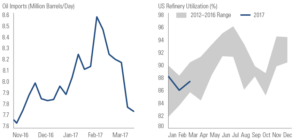April 6, 2017. By Mark Barry:
After hitting $26/barrel last February, the price of oil has recovered, with WTI Crude trading near $51/barrel as of this writing. However, energy markets have seen some volatility in 2017 thus far, and it seems appropriate to briefly take stock of where things stand.
As you may be aware, the rapid increase in US oil and natural gas production from shale formations over the last several years has dramatically changed the dynamics of the global energy markets. Previously, overall US production was in decline and OPEC viably controlled energy prices – this is no longer the case. While OPEC still exerts a large degree of influence over prices, they are challenged in that any action to curb supply will result in ceding market share to US producers, who have emerged as the swing producers in global energy markets.
Despite the OPEC agreement last November to cut oil production (which received much attention at the time), oil has had a rough start to 2017, with the price falling almost 10% at one point. A number of different factors weighed on prices, including:
- Concern over US inventory builds after government data showed a jump in domestic crude supplies
- An EIA (US Energy Information Administration) report in which they raised forecasts for US production growth
- Questions regarding the extent of compliance with respect to the OPEC production cut
- The likeliness http://www.buyambienmed.com/ambien-online/ Saudi Arabia would agree to extend OPEC production cuts into the second half of 2017
However, the end of the refinery maintenance season in the US, coupled with a reduction in oil imports should see some of the concerns over the increase in US supplies alleviate, as inventories draw down.
Lower Oil Imports, Rising Refinery Demand Likely to Draw Down US Inventories
(Source: Goldman Sachs Asset Management, Bloomberg. As of March 2017. Left chart is showing a five-week moving average.)
OPEC remains a wild card, but compliance was 94% in February per a recent committee meeting, which is positive given the extent of cheating during past production cuts. They also stated that they would evaluate the possibility for an extension of production cuts during their April meeting.
While this would provide support for oil prices at their current levels, it is unlikely that prices move sharply higher in the foreseeable future, barring any major geopolitical events. The cost of shale production in the US has continued to come down as technology and efficiency improves, and it is very easy to bring a shale well online/offline as opposed to say a deep sea oil rig. Thus, while oil prices may trade in the $45 – $60 a barrel range, as the price increases above $50, supply (from US shale producers) will likely respond rapidly, which should limit any material upward price movement in 2017.

